Abstract
Injury of the oesophageal mucosa can result from exposure to refluxed gastric acid and pepsin. Competence of the lower oesophageal sphincter and peristaltic activity serve to reduce contract time between luminal acid and oesophageal mucosa, but intraluminal neutralisation of residual acid by bicarbonate may also be important in preventing oesophageal mucosal injury. Whereas swallowed saliva contains bicarbonate, recent experiments have also demonstrated alkali secretion from the mammalian oesophagus. Bicarbonate secretion from the human oesophagus was therefore examined with an intubation technique and perfusion of the oesophagus with a non-absorbable marker. Saliva, gastric, and oesophageal aspirates were collected and bicarbonate concentrations determined by measurements of pH and pCO2 or by back titration. In 32 normal subjects (17 women, 15 men) median basal oesophageal bicarbonate secretion determined by a pH/pCO2 method was 416 (range 139-1050) mumol/hour/10 cm. In a subgroup of 15 experiments median oesophageal bicarbonate output was 489 (range 157-1033) mumol/hour/10 cm (pH/pCO2 method) compared with a median alkali output of 563 (range 135-799) mumol/hour/10 cm as determined by back titration. The difference was not significant. Salivary contamination of the oesophagus accounted for 25% of all bicarbonate measured within the oesophagus and refluxed gastric bicarbonate accounted for 2.5%. Bicarbonate secretion from the normal human oesophagus may, in combination with swallowed salivary bicarbonate, play a part in preventing oesophageal mucosal damage due to refluxed gastric acid and pepsin.
Full text
PDF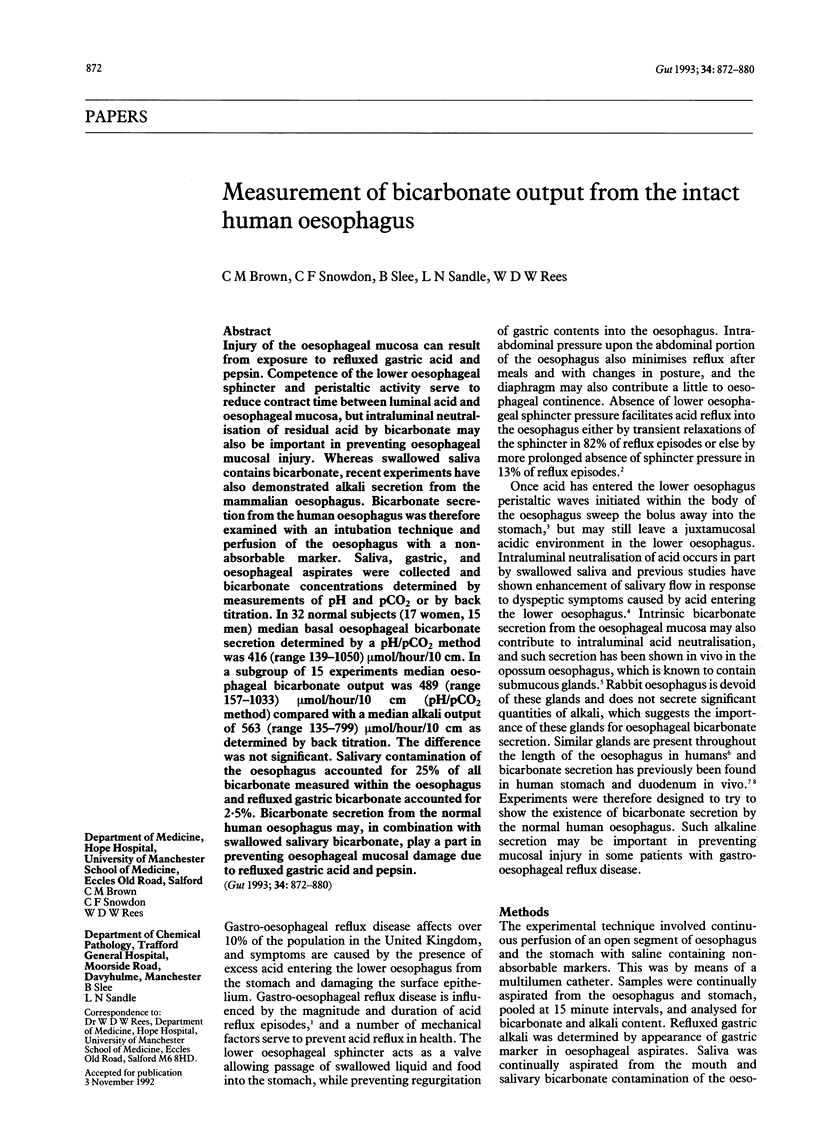
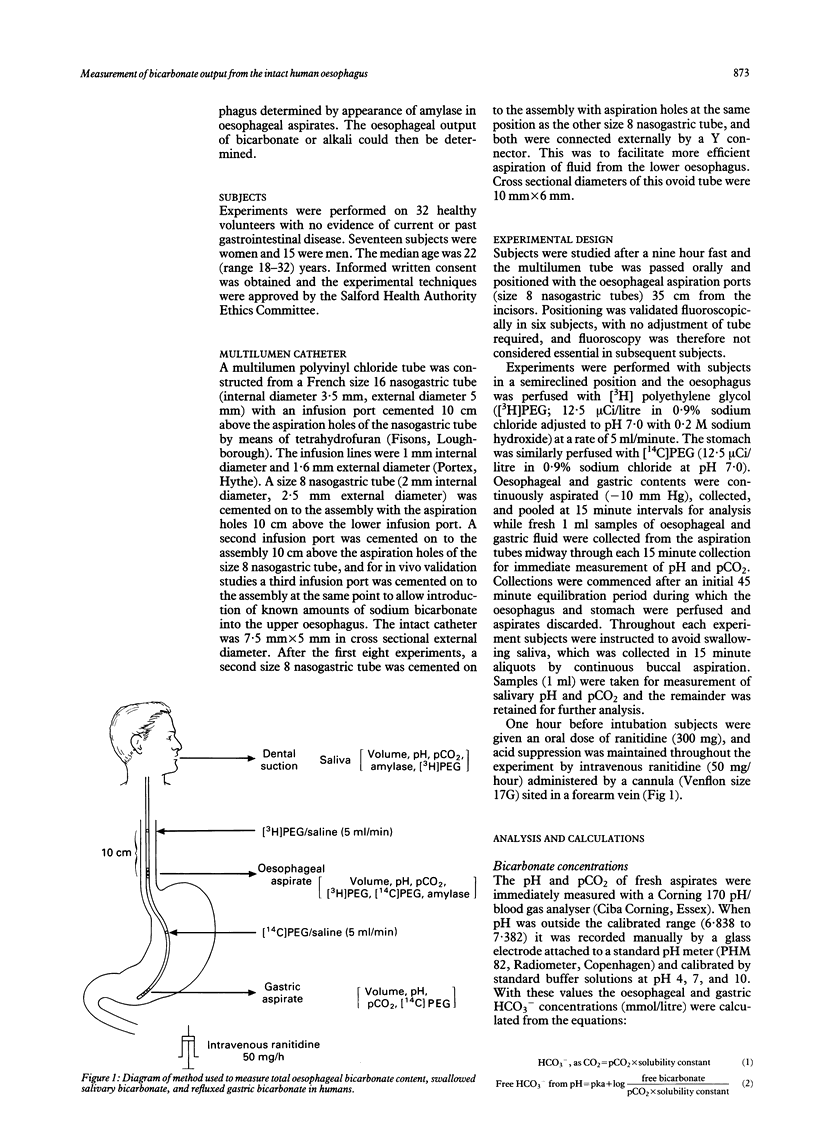
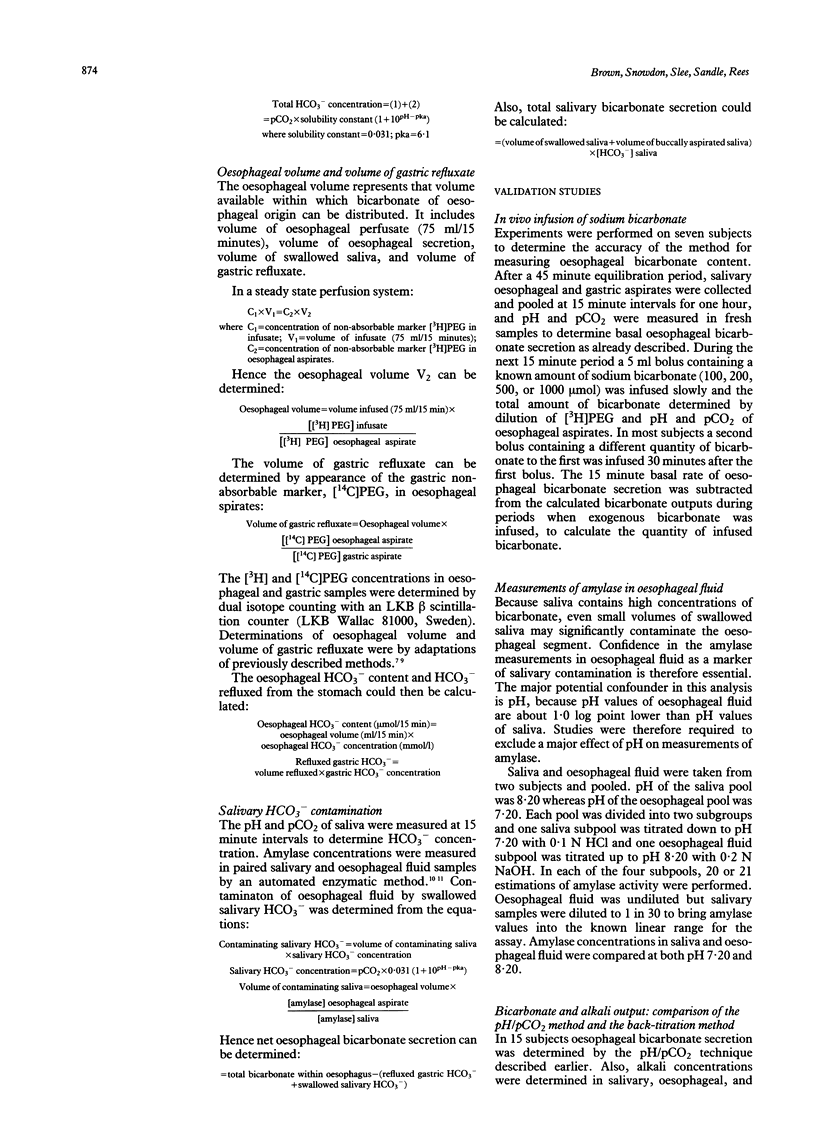
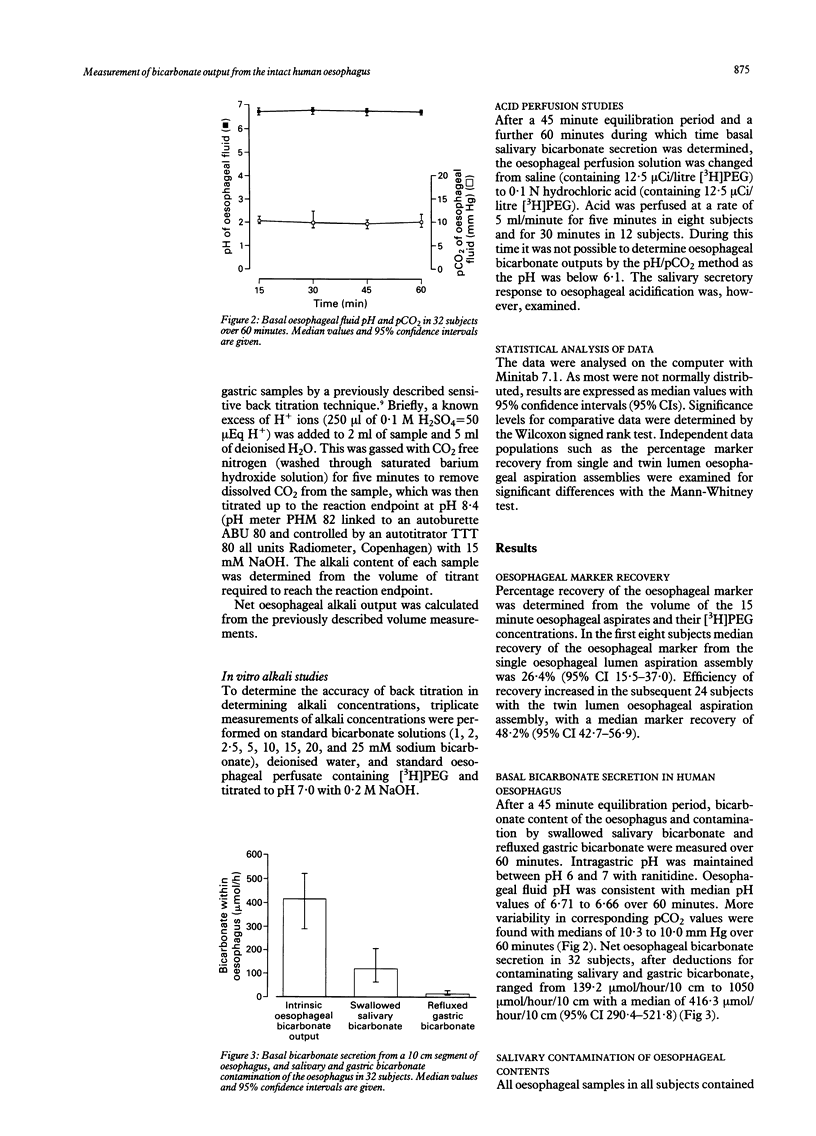
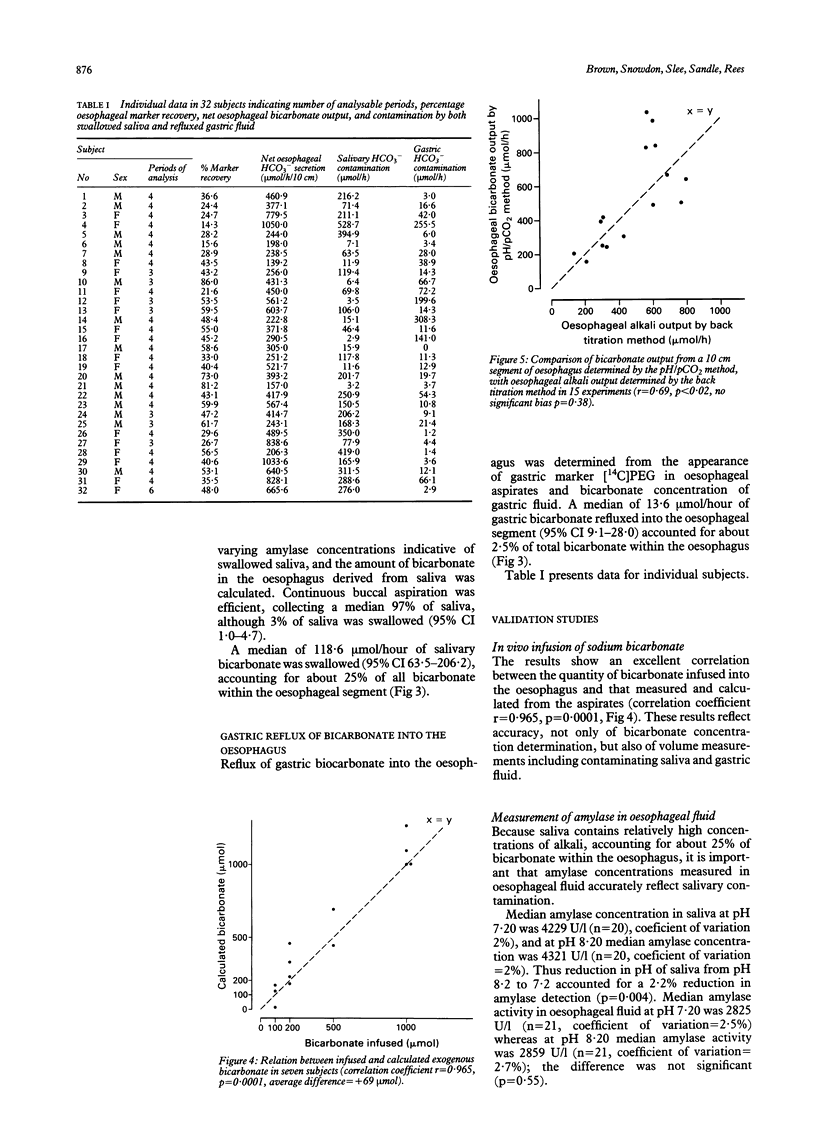
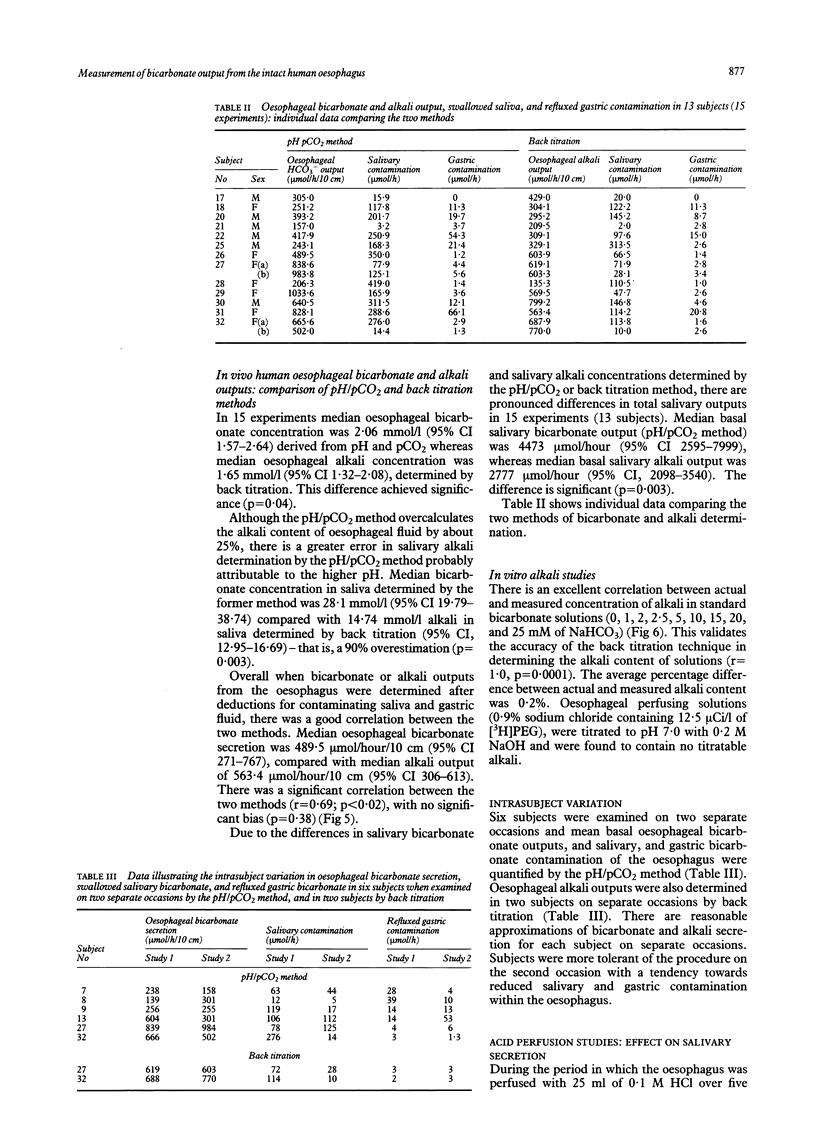
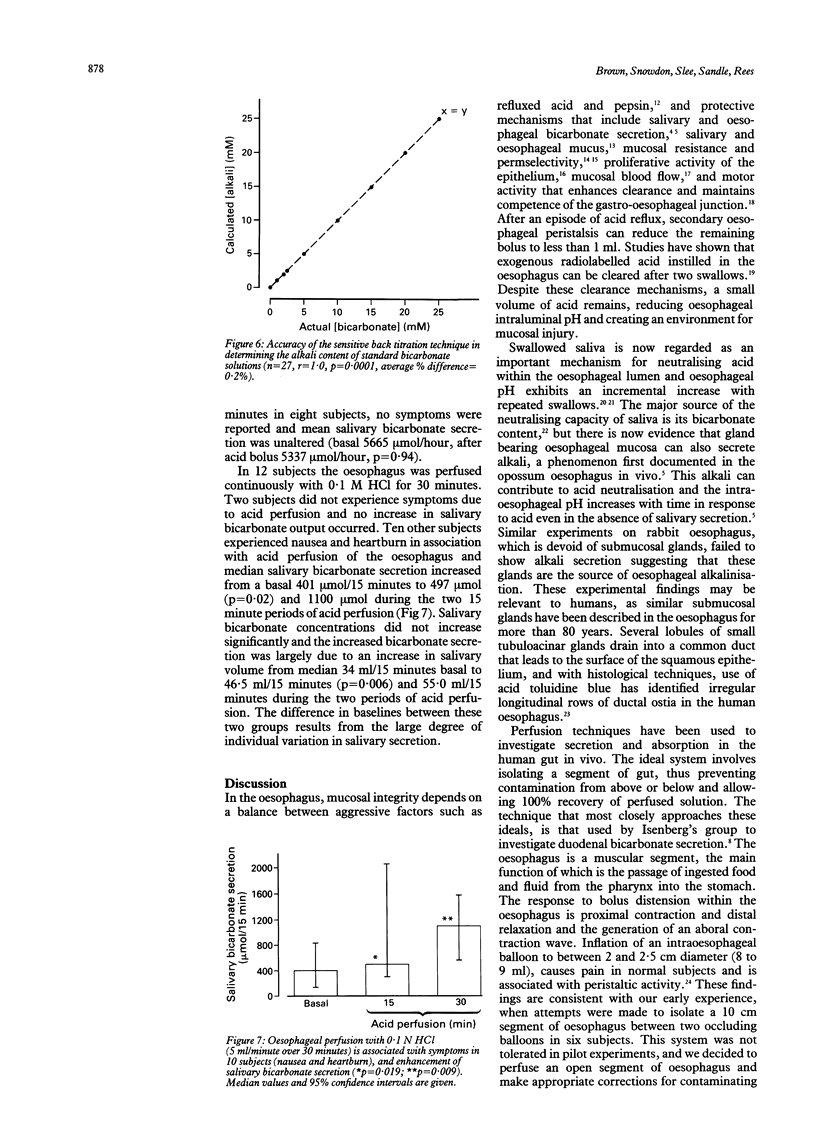
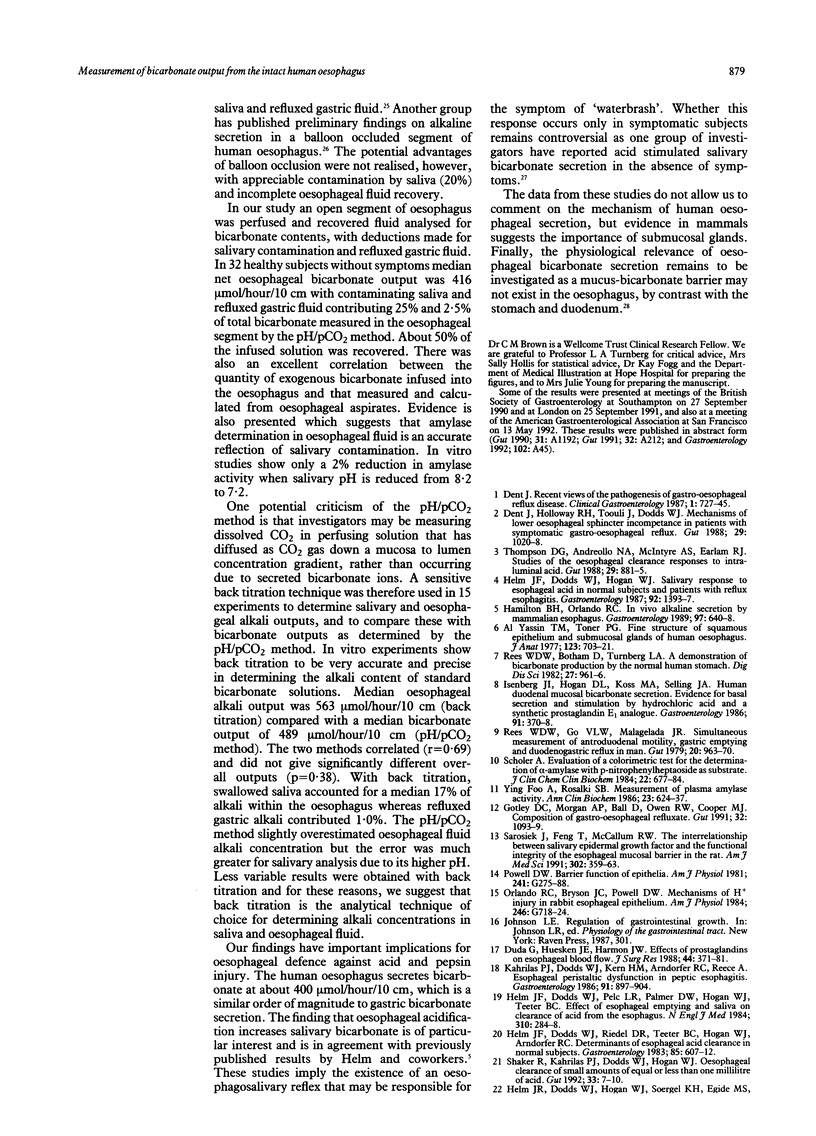
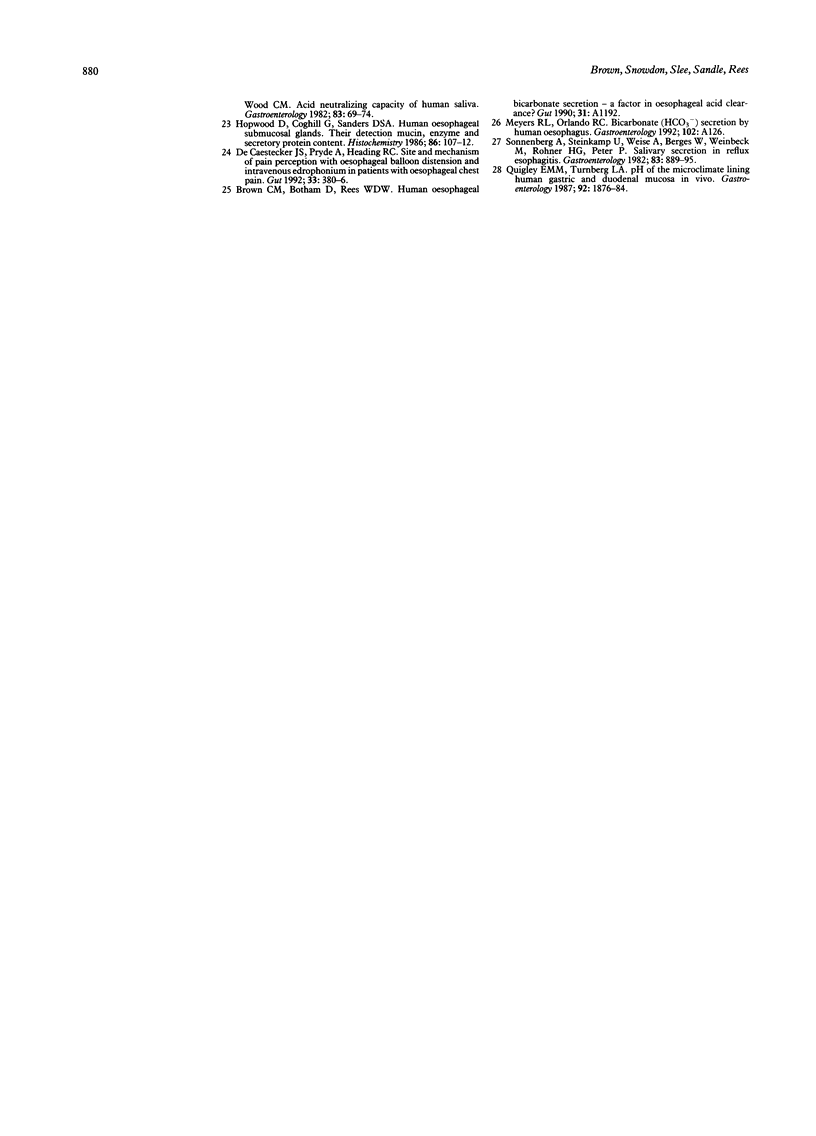
Selected References
These references are in PubMed. This may not be the complete list of references from this article.
- Dent J., Holloway R. H., Toouli J., Dodds W. J. Mechanisms of lower oesophageal sphincter incompetence in patients with symptomatic gastrooesophageal reflux. Gut. 1988 Aug;29(8):1020–1028. doi: 10.1136/gut.29.8.1020. [DOI] [PMC free article] [PubMed] [Google Scholar]
- Dent J. Recent views on the pathogenesis of gastro-oesophageal reflux disease. Baillieres Clin Gastroenterol. 1987 Oct;1(4):727–745. doi: 10.1016/0950-3528(87)90016-9. [DOI] [PubMed] [Google Scholar]
- Duda G., Huesken J. E., Harmon J. W. Effects of prostaglandins on esophageal blood flow. J Surg Res. 1988 Apr;44(4):371–381. doi: 10.1016/0022-4804(88)90179-5. [DOI] [PubMed] [Google Scholar]
- Foo A. Y., Rosalki S. B. Measurement of plasma amylase activity. Ann Clin Biochem. 1986 Nov;23(Pt 6):624–637. doi: 10.1177/000456328602300602. [DOI] [PubMed] [Google Scholar]
- Gotley D. C., Morgan A. P., Ball D., Owen R. W., Cooper M. J. Composition of gastro-oesophageal refluxate. Gut. 1991 Oct;32(10):1093–1099. doi: 10.1136/gut.32.10.1093. [DOI] [PMC free article] [PubMed] [Google Scholar]
- Hamilton B. H., Orlando R. C. In vivo alkaline secretion by mammalian esophagus. Gastroenterology. 1989 Sep;97(3):640–648. doi: 10.1016/0016-5085(89)90635-5. [DOI] [PubMed] [Google Scholar]
- Helm J. F., Dodds W. J., Hogan W. J. Salivary response to esophageal acid in normal subjects and patients with reflux esophagitis. Gastroenterology. 1987 Dec;93(6):1393–1397. doi: 10.1016/0016-5085(87)90270-8. [DOI] [PubMed] [Google Scholar]
- Helm J. F., Dodds W. J., Hogan W. J., Soergel K. H., Egide M. S., Wood C. M. Acid neutralizing capacity of human saliva. Gastroenterology. 1982 Jul;83(1 Pt 1):69–74. [PubMed] [Google Scholar]
- Helm J. F., Dodds W. J., Pelc L. R., Palmer D. W., Hogan W. J., Teeter B. C. Effect of esophageal emptying and saliva on clearance of acid from the esophagus. N Engl J Med. 1984 Feb 2;310(5):284–288. doi: 10.1056/NEJM198402023100503. [DOI] [PubMed] [Google Scholar]
- Helm J. F., Dodds W. J., Riedel D. R., Teeter B. C., Hogan W. J., Arndorfer R. C. Determinants of esophageal acid clearance in normal subjects. Gastroenterology. 1983 Sep;85(3):607–612. [PubMed] [Google Scholar]
- Hopwood D., Coghill G., Sanders D. S. Human oesophageal submucosal glands. Their detection mucin, enzyme and secretory protein content. Histochemistry. 1986;86(1):107–112. doi: 10.1007/BF00492353. [DOI] [PubMed] [Google Scholar]
- Isenberg J. I., Hogan D. L., Koss M. A., Selling J. A. Human duodenal mucosal bicarbonate secretion. Evidence for basal secretion and stimulation by hydrochloric acid and a synthetic prostaglandin E1 analogue. Gastroenterology. 1986 Aug;91(2):370–378. [PubMed] [Google Scholar]
- Kahrilas P. J., Dodds W. J., Hogan W. J., Kern M., Arndorfer R. C., Reece A. Esophageal peristaltic dysfunction in peptic esophagitis. Gastroenterology. 1986 Oct;91(4):897–904. doi: 10.1016/0016-5085(86)90692-x. [DOI] [PubMed] [Google Scholar]
- Orlando R. C., Bryson J. C., Powell D. W. Mechanisms of H+ injury in rabbit esophageal epithelium. Am J Physiol. 1984 Jun;246(6 Pt 1):G718–G724. doi: 10.1152/ajpgi.1984.246.6.G718. [DOI] [PubMed] [Google Scholar]
- Powell D. W. Barrier function of epithelia. Am J Physiol. 1981 Oct;241(4):G275–G288. doi: 10.1152/ajpgi.1981.241.4.G275. [DOI] [PubMed] [Google Scholar]
- Quigley E. M., Turnberg L. A. pH of the microclimate lining human gastric and duodenal mucosa in vivo. Studies in control subjects and in duodenal ulcer patients. Gastroenterology. 1987 Jun;92(6):1876–1884. doi: 10.1016/0016-5085(87)90619-6. [DOI] [PubMed] [Google Scholar]
- Rees W. D., Botham D., Turnberg L. A. A demonstration of bicarbonate production by the normal human stomach in vivo. Dig Dis Sci. 1982 Nov;27(11):961–966. doi: 10.1007/BF01391739. [DOI] [PubMed] [Google Scholar]
- Rees W. D., Go V. L., Malagelada J. R. Simultaneous measurement of antroduodenal motility, gastric emptying, and duodenogastric reflux in man. Gut. 1979 Nov;20(11):963–970. doi: 10.1136/gut.20.11.963. [DOI] [PMC free article] [PubMed] [Google Scholar]
- Sarosiek J., Feng T., McCallum R. W. The interrelationship between salivary epidermal growth factor and the functional integrity of the esophageal mucosal barrier in the rat. Am J Med Sci. 1991 Dec;302(6):359–363. doi: 10.1097/00000441-199112000-00007. [DOI] [PubMed] [Google Scholar]
- Scholer A., Hohenwallner W. Evaluation of a colorimetric test for the determination of alpha-amylase with p-nitrophenylheptaoside as substrate. J Clin Chem Clin Biochem. 1984 Oct;22(10):677–684. doi: 10.1515/cclm.1984.22.10.677. [DOI] [PubMed] [Google Scholar]
- Shaker R., Kahrilas P. J., Dodds W. J., Hogan W. J. Oesophageal clearance of small amounts of equal or less than one millilitre of acid. Gut. 1992 Jan;33(1):7–10. doi: 10.1136/gut.33.1.7. [DOI] [PMC free article] [PubMed] [Google Scholar]
- Sonnenberg A., Steinkamp U., Weise A., Berges W., Wienbeck M., Rohner H. G., Peter P. Salivary secretion in reflux esophagitis. Gastroenterology. 1982 Oct;83(4):889–895. [PubMed] [Google Scholar]
- Thompson D. G., Andreollo N. A., McIntyre A. S., Earlam R. J. Studies of the oesophageal clearance responses to intraluminal acid. Gut. 1988 Jul;29(7):881–885. doi: 10.1136/gut.29.7.881. [DOI] [PMC free article] [PubMed] [Google Scholar]


